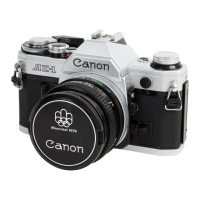I
speed when using a standard 50mm lens. For
'
indoor photography, with no special illumi-
I
nation, choose 1/30 of a second and 1/60 of a
I
second in a brightly lit room.
For outdoor photography, select
11125
second when cloudy and 11250 second in
1
sunshine. To take pictures in particularly
I
bright sunshine such as at a beach in mid-
!
summer or in snow-covered mountains, use
I
shutter speeds of 11500 sec. or 111000 sec.
The above mentioned shutter speeds
!
apply when using a standard 50mm lens, but
it
is
necessary to choose faster shutter speeds
i
when using lenses of longer focal lengths
i
because they are more difficult to hold
steady.
It
is
generally said that the shutter
speed-figure should be greater than
1
divided
by the focal length of the lens in order to ob-
tain sharp images.
For example, when using a
200mm tele-
1
photo lens. shutter speed should
be
faster
I
than 11200 second, therefore the shutter
speed in this particular case should be
set
at
.I1250 sec. Image blur can also arise if the
camera
is
not properly held. See page 37.
2
Reading
the
Exposure
This camera incorporates a magnetic
release system using an electromagnetic switch
to effectively perform instantaneous light
metering. The shutter release button activates
light metering and exposure in succession and
practically simultaneously.
This is a
twostep shutter button. The
exposure can be confirmed by the meter
needle inside the viewfinder by pressing the
shutter button halfway.
When the meter needle inside the view-
finder stays within the proper range and the
underexposure warning
LED
lamp below the
aperture scale inside the viewfinder does not
blink, the exposure is correct. See page 45
about the underexposure warning lamp.
When the underexposure warning lamp
inside the viewfinder blinks, or when the
meter needle moves into the upper over-
exposure warning zone in red, the exposure is
incorrect. When this is the case, turn the

